Mariadb Galera Cluster Show Status

Galera Cluster For Mysql The World S Most Advanced Open Source Database Cluster

How To Set Up Mariadb Galera Cluster On Ubuntu 18 04 18 10 And 16 04
9 Tips For Going In Production With Galera Cluster For Mysql Severalnines
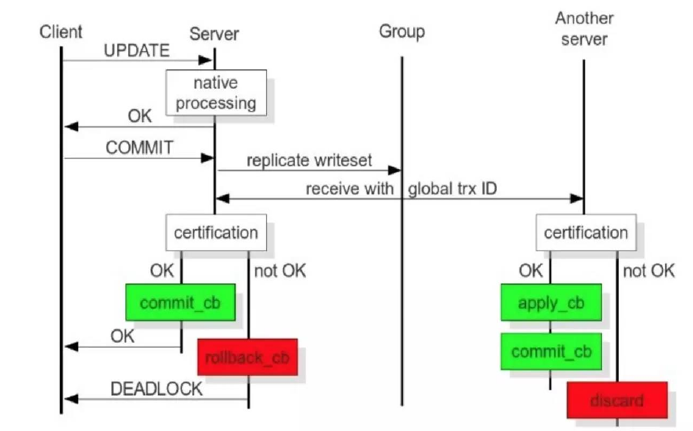
Mysql Cluster Highly Available

Galera Cluster With Mariadb 10 And Asynchronous Slave Database Administrators Stack Exchange

Galera Replication Principle Detailed Programmer Sought
3) And started a new cluster galera_new_cluster 4) All other nodes I reconnected to the new one systemctl restart mariadb PS to install killall on CentOS use psmisc sudo yum install psmisc Solution 2 Another way to restart a MariaDB Galera Cluster is to use wsrepnewcluster parameter 1) Kill all mysql processes.

Mariadb galera cluster show status. MariaDB Enterprise Server 104 and 105 installations use an enterprisebuild of the Galera 4 plugin This includes all the features of Galera Cluster 4 as well as enterprise features like GCache encryption To enable MariaDB Enterprise Cluster, use the libgalera_enterprise_smmso library. Galera Status Variables Do these exercises after viewing the first two sections of the training video Galera Monitoring Overview , and Galera Status Variables With MySQL or MariaDB, and Galera running on all three nodes, execute the SHOW STATUS statement with the LIKE operator to obtain a list of all variables with the prefix wsrep. Step 7 Testing Replication On The Galera Cluster We can test the replication between cluster nodes are functioning as expected by creating a test database on one node and viewing the database list on another node.
Galera is a multimaster cluster for MariaDB which replicates data using synchronous replication Galera allows any nodes in the cluster to act as master and write to any node at a time The activeactive configuration of Galera cluster provides more load balancing and fault tolerance since there is no failover. Viewing Galera Cluster Status variables Galera Status variables can be viewed with the SHOW STATUS statement SHOW STATUS LIKE 'wsrep%';. Variable_name Value wsrep_local_state_uuid.
The Situation MariaDB, a fork of MySQL, has had multimaster clustering support from the the initial version 10 release However, the more recent releases have made it increasingly easy to setup a multimaster database cluster. Step 3 Bootstrapping the cluster Make sure MariaDB is stopped/inactive on all nodes before proceeding systemctl status mariadbservice To start the cluster, a node first needs to create it On Debian 10, this can be done with the galera_new_cluster script The script should only be executed on one node, and only once to initialize the cluster. To prevent this, Galera Cluster checks writesets against all writesets within its certification interval for potential conflicts Using the wsrep_cert_interval status variable, you can see the average number of transactions with the certification interval To see retrieve the value of this status variable, execute the SHOW STATUS statement.
See also the Full list of MariaDB options, system and status variables List of Galera Cluster Status variables MariaDB Galera Cluster has the following status variables wsrep_apply_oooe. Starting the Server MariaDB Community Server includes configuration to start, stop, restart, enable/disable on boot, and check the status of the Server using the operating system default process management system Note that when the cluster is not running, you need to bootstrap the first Server. Without using the galera_new_cluster script that allows systemd to pass Your MariaDB Cluster is setup completed successfully $ mysql u root p e "SHOW STATUS LIKE 'wsrep_cluster_size.
The answer to monitor Galera cluster status from command line is this command # mysql u root p exec="SHOW STATUS LIKE 'wsrep%';" Example root@mariadb01 ~# mysql u root p exec="SHOW STATUS LIKE 'wsrep%';" grep wsrep_local_state_commentwsrep_local_state_comment Synced. Viewing Galera Cluster Status variables Galera Status variables can be viewed with the SHOW STATUS statement SHOW STATUS LIKE 'wsrep%';. MariaDB Galera Cluster is a synchronous multimaster cluster for MariaDB It is a fork of Galera Cluster, the world's most advanced, free and open source cluster engineCurrently, it only supports InnoDB storage engines MariaDB Galera Cluster is a true MultiMaster and ActiveActive cluster.
MariaDB Galera Cluster is a synchronous multimaster cluster for MariaDB It is available on Linux only, and only supports the XtraDB/InnoDB storage engines Starting with MariaDB 101, the wsrep API for Galera Cluster is included by defaultThis is available as a separate download for MariaDB 103 and MariaDB 55 Features. Step 4 Start Galera Cluster on Ubuntu 1804 Stop mariadb on all three nodes # systemctl stop mariadb Now start new Galera cluster on node 1 – galeranode01 # galera_new_cluster Check Galera status if it’s running. Without using the galera_new_cluster script that allows systemd to pass Your MariaDB Cluster is setup completed successfully $ mysql u root p e "SHOW STATUS LIKE 'wsrep_cluster_size.
See also the Full list of MariaDB options, system and status variables List of Galera Cluster Status variables MariaDB Galera Cluster has the following status variables wsrep_apply_oooe. Following documentation on how to set up a MariaDB Galera cluster, I simply created the proper config files and started my primary db server with the galera_new_cluster command (I'm running RHEL7) According to the documentation, at that point you should be able to run SHOW STATUS LIKE 'wsrep_cluster_size';. The Situation MariaDB, a fork of MySQL, has had multimaster clustering support from the the initial version 10 release However, the more recent releases have made it increasingly easy to setup a multimaster database cluster.
Check MariaDB cluster status To check the status of your MariaDB cluster, log in to the master or primary database server host using SSH, start the MariaDB commandline client using your administrative credentials, and run the following command within it. Viewing Galera Cluster Status variables Galera Status variables can be viewed with the SHOW STATUS statement SHOW STATUS LIKE 'wsrep%';. Following documentation on how to set up a MariaDB Galera cluster, I simply created the proper config files and started my primary db server with the galera_new_cluster command (I'm running RHEL7) According to the documentation, at that point you should be able to run SHOW STATUS LIKE 'wsrep_cluster_size';.
See also the Full list of MariaDB options, system and status variables List of Galera Cluster Status variables MariaDB Galera Cluster has the following status variables wsrep_apply_oooe. Configure MariaDB Galera Cluster All nodes in cluster become MasterServer in this configuration. See also the Full list of MariaDB options, system and status variables List of Galera Cluster Status variables MariaDB Galera Cluster has the following status variables wsrep_applier_thread_count.
If the time between FLUSH STATUS and SHOW STATUS was one minute and the node returned 025, it indicates that the node was paused for a total 15 seconds over that time period Ideally, the return value should stay as close to 00 as possible, since this means the node is not falling behind the cluster. Here is the complete guide on setting up an HA MySQL cluster with Galera The environment we used was ubuntu based Install MariaDB on all nodes. Galera Clusterの起動 db1のMariaDB Galera Cluster起動確認 db1の起動確認です。 このとき、db2とdb3は停止状態です。 ※ Galera Clusterでは、初期設定ファイルの「wsrep_cluster_address」に記述されたノードのどれかが起動していないと、起動できません。 1台目(ファーストノード)を起動する際には、他の.
Contribute to piwi3910/ansiblemariadbgaleracluster development by creating an account on GitHub. Setting up Galera Cluster is somewhat tricky at first, however there are many tutorials describing the process Minimum cluster size size is two, so we need at least two servers running MariaDB instances, configured to interchange data with each other Cluster Configuration In this example configuration of two nodes, we assume that the servers are connected over private network. Prepare db user in Galera Cluster (mysqluser table is not replicated across cluster, so you have to insert db user into each of your mariadb servers) Import schema (with innodb engine) Import data.
Controll MariaDB Galera Cluster Settings Login into DB console as the cluster root user mysql u root p Confirm if Cluster settings are OK show status like 'wsrep_%';. Run the following command to find the cluster size mysql u root p e "SHOW STATUS LIKE 'wsrep_cluster_size'" You will see the following output, which indicates that the third node has joined the cluster and that the total number of nodes in the cluster is three. And see Variable_name Value wsrep_cluster_size 1.
Galera Clusterの起動 db1のMariaDB Galera Cluster起動確認 db1の起動確認です。 このとき、db2とdb3は停止状態です。 ※ Galera Clusterでは、初期設定ファイルの「wsrep_cluster_address」に記述されたノードのどれかが起動していないと、起動できません。 1台目(ファーストノード)を起動する際には、他の. Controll MariaDB Galera Cluster Settings Login into DB console as the cluster root user mysql u root p Confirm if Cluster settings are OK show status like 'wsrep_%';. To prevent this, Galera Cluster checks writesets against all writesets within its certification interval for potential conflicts Using the wsrep_cert_interval status variable, you can see the average number of transactions with the certification interval To see retrieve the value of this status variable, execute the SHOW STATUS statement like so.
Galera Cluster variables are related to writeset replication and thereby prefixed with wsrep_ To retrieve a list of all of these status variables, you would enter the following SQL statement on each node, using a simple database client, such as mysql SHOW GLOBAL STATUS LIKE 'wsrep_%';. MariaDB Galera server logs all the cluster related information like node status, cluster status, membership, etc in the error log MariaDB 1012 introduces a new INFORMATION SCHEMA plugin WSREP_INFO that enables querying these information via INFORMATION SCHEMA tables The WSREP_INFO plugin adds two new tables to the Information Schema, WSREP_MEMBERSHIP and WSREP_STATUS. You should now see your cluster confiuguration Check „wsrep_cluster_size“ which should be „3“.
To install MariaDB Galera Cluster with yum or dnf, follow the instructions at Installing MariaDB Galera Cluster with yum Installing MariaDB Galera Cluster with aptget On Debian, Ubuntu, and other similar Linux distributions, it is highly recommended to install the relevant DEB packages from MariaDB's repository using aptget. MariaDB (none)> show status like 'wsrep%';. Viewing Galera Cluster Status variables Galera Status variables can be viewed with the SHOW STATUS statement SHOW STATUS LIKE 'wsrep%';.
You should now see your cluster confiuguration Check „wsrep_cluster_size“ which should be „3“. Note MariaDB Server 104 has Galera 4 installed by default, therefore we will cover all steps to install and configure MariaDB and the steps necessary to configure the default install of Galera Cluster MariaDB and Galera Cluster Instantiate a server with Ubuntu 1804 (Bionic Beaver) and name it galeramariadb1 We will refer it to by name. Setting up Galera Cluster is somewhat tricky at first, however there are many tutorials describing the process Minimum cluster size size is two, so we need at least two servers running MariaDB instances, configured to interchange data with each other Cluster Configuration In this example configuration of two nodes, we assume that the servers are connected over private network.
Without using the galera_new_cluster script that allows systemd to pass the wsrepnewcluster parameter, a normal systemctl start mariadb would fail because there are no nodes running for the first node to connect with sudo galera_new_cluster This command will not display any output on successful execution. And see Variable_name Value wsrep_cluster_size 1. Some activepassive clusters also allow SELECT operations on passive nodes In an activeactive cluster, every node is readwrite and a change made to one is replicated to all In this guide, we will configure an activeactive MariaDB Galera cluster For demonstration purposes, we will configure and test three nodes, the smallest configurable.
Configure MariaDB Galera Cluster All nodes in cluster become MasterServer in this configuration. Setting up Galera Cluster is somewhat tricky at first, however there are many tutorials describing the process Minimum cluster size size is two, so we need at least two servers running MariaDB instances, configured to interchange data with each other Cluster Configuration In this example configuration of two nodes, we assume that the servers are connected over private network. Step 4 Start Galera Cluster on Ubuntu 1804 Stop mariadb on all three nodes # systemctl stop mariadb Now start new Galera cluster on node 1 – galeranode01 # galera_new_cluster Check Galera status if it’s running # mysql u root p e "show status like 'wsrep_%'" Enter password Variable_name Value wsrep_apply_oooe.
Viewing Galera Cluster Status variables Galera Status variables can be viewed with the SHOW STATUS statement SHOW STATUS LIKE 'wsrep%';. Mysql > show slave status\G I was able to see this in the show slave status command Slave_IO_Running Yes Slave_SQL_Running Yes Seconds_Behind_Master 0 The seconds_behind_master always let me know if I was behind on one of my servers I am not using galera and am not sure how to verify if everything is up to date. Staring the Galera Cluster After this have been configured you need to start the cluster First on the mariadb01 node which is the master with this command galera_new_cluster Then on other two nodes with normal systemctl command systemctl start mariadb Next we can verify that cluster is running mysql u root p e "SHOW STATUS LIKE 'wsrep.
With MariaDB 101, the wsrep API for Galera Cluster is included by default This is available as a separate download for MariaDB 100 and MariaDB 55 If you need to do that for older version you can follow the steps here If you want to do this for 101 you can follow the steps at Galera Cluster & MariaDB 101 On CentOS 7 Server. See also the Full list of MariaDB options, system and status variables List of Galera Cluster Status variables MariaDB Galera Cluster has the following status variables wsrep_apply_oooe. From the show status output your servers don't load any wsrep provider (Galera), and probably don't even attempt to As little as I understand in how mysql configuration file works, I think you need to put mysqld before MariaDB/Galera settings (or put them immediately after InnoDB settings) Otherwise they seem to be in the isamcheck section and simply are not parsed by the server.
Prepare db user in Galera Cluster (mysqluser table is not replicated across cluster, so you have to insert db user into each of your mariadb servers) Import schema (with innodb engine) Import data. But just in case any one looking for the exact answer about how to safely shutdown and restart the mariadb galera cluster For example we have three mariadb galera nodes(1,2,3) running on ubuntu servers To stop/shutdown the cluster in safe way without destroying the cluster Make sure no active transactions or connections against the cluster. View_id is the number of cluster configuration changes, corresponding to the status variable wsrep_cluster_conf_id view_seqno is the latest Galera sequence number, corresponding to the status variable wsrep_last_committed protocol_version is the MariaDB wsrep patch version, corresponding to the status variable wsrep_protocol_version.
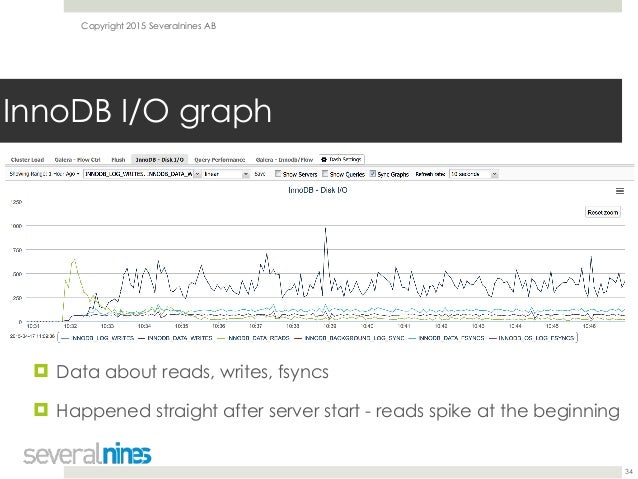
Deep Dive Into How To Monitor Mysql Or Mariadb Galera Cluster Perco

How To Set Up Mariadb Galera Cluster On Ubuntu 18 04 18 10 And 16 04
Mariadb Galera Cluster Administration Guide Platforms And Networks Confluence

Mariadb Galera Cluster On Centos 7
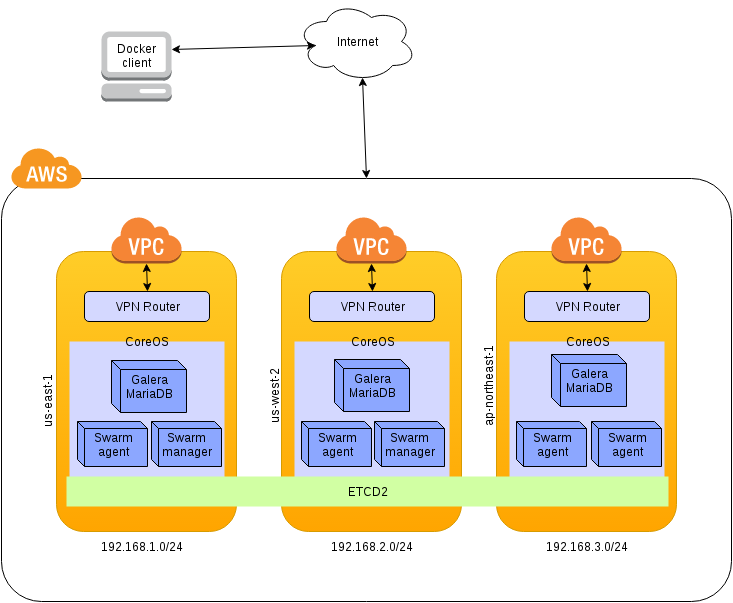
Github Daper Galera Cluster Galera Cluster On Ec2

How To Install And Configure Mariadb Galera Cluster

How To Create A Galera Cluster With Mariadb 10 2 On Centos Servers Mariadb Admin Tutorial Youtube
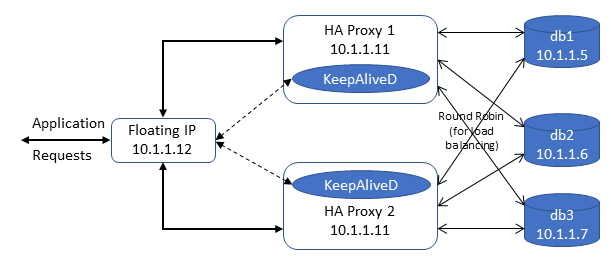
Highly Available Load Balanced Mariadb Cluster Using Galera Haproxy And Keepalived Online Notes

How To Set Up Mariadb Master Slave Replication With Galera Cluster On Ubuntu

Native Galera Support In Proxysql Proxysql

High Availability Apache Galera Cluster With Haproxy Load Balancer Tuxfixer Com

Configuring Galera Cluster For Mariadb Production Ready Openstack Recipes For Successful Environments

How To Set Up Mariadb Master Slave Replication With Galera Cluster On Ubuntu

Nodejs Mariadb Galera Is It The Right Choice For Scalable Ecommerce Api By Mindaugas Varkalys The Startup Medium

How To Setup Mariadb Galera Cluster With Haproxy On Centos 7

Mysql Multi Master Replication With Galera Sebastien Han

Monitoring Galera Cluster For Mysql Or Mariadb Understanding Metrics Updated Severalnines

Monitoring The Cluster

Mariadb 10 1 Galera Cluster On Centos 7 Blog By Nitin J Mutkawoa
Installing Mariadb Galera On Ibm Cloud Mariadb Knowledge Base

How To Set Up A Mariadb Galera Cluster On Ubuntu 16 04 Techrepublic

Galera Cluster Vs Pxc Vs Mariadb Galera Cluster Benchmarking Fromdual
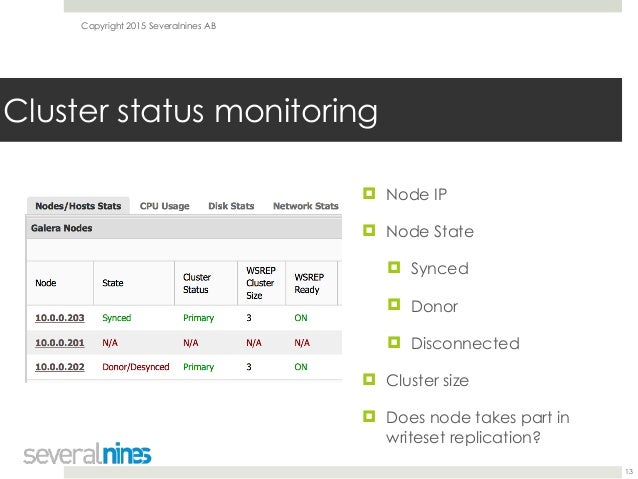
Deep Dive Into How To Monitor Mysql Or Mariadb Galera Cluster Perco

Improve Performance Of Galera Cluster For Mysql Or Mariadb Severalnines
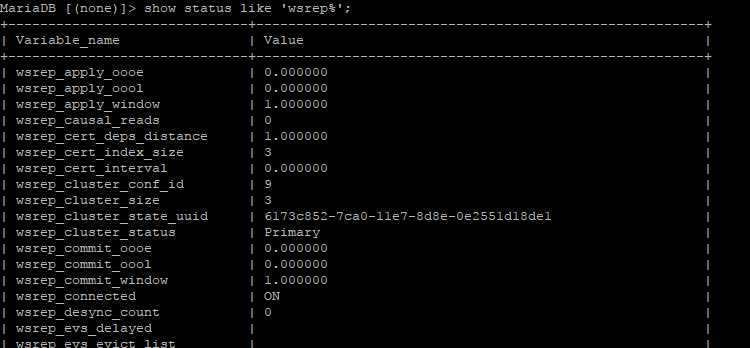
Galera Cluster Mariadb Configuration On Centos 7 Linuxadmin Io

Galera Cluster Data Consistency Youtube

Debugging Mariadb Galera Cluster Sst Problems A Tale Of A Funny Experience Percona Database Performance Blog
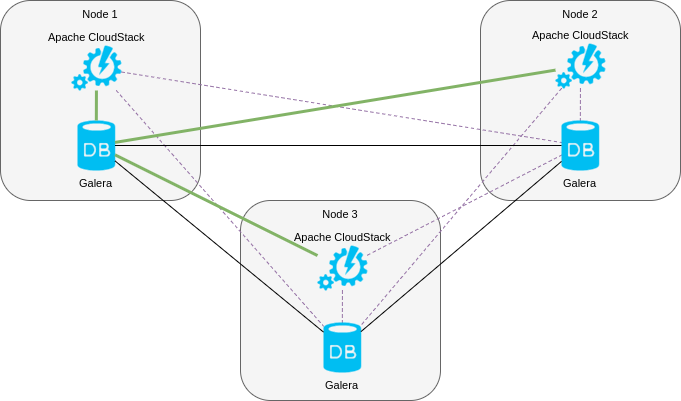
Configuring Highly Available Apache Cloudstack 4 9 2 With Mariadb Galera Cluster

Mariadb Galera Cluster Configuration In Ubuntu Debian Environment

Connection Issue With Mariadb And Haproxy Cluster Stack Overflow

How To Deploy A Mariadb Galera Cluster On Ubuntu 14 04 Vexxhost

Running A Mariadb Galera Cluster On Openshift

How To Configure Mariadb Maxscale Master Slave With Galera Cluster

Choosing Between Codership S Mysql Galera Mariadb Galera Cluster And

How To Install And Configure Mariadb Galera As Master To Master Replication Cluster On Ubuntu 16 04 Lts Nixcraft

How To Set Up A Mariadb Galera Cluster On Ubuntu 16 04 Techrepublic
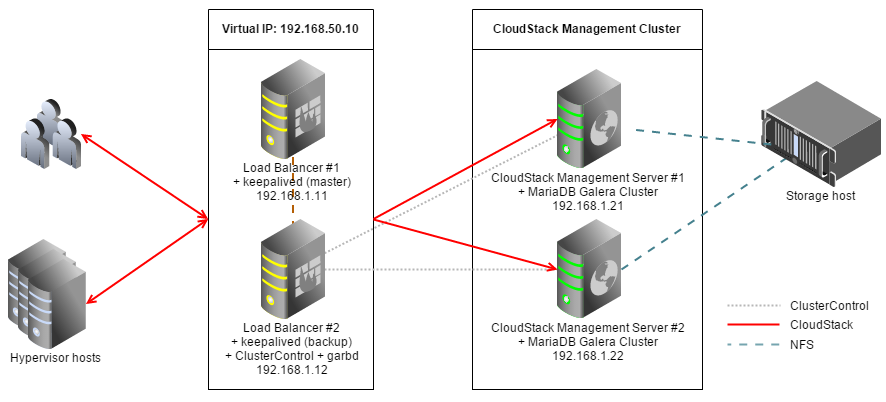
How To Deploy High Availability Cloudstack With Mariadb Galera Cluster The Cloudstack Company

Galera Cluster For Mysql The World S Most Advanced Open Source Database Cluster

Monitoring Galera Cluster For Mysql Or Mariadb Understanding Metrics Updated Severalnines

Personal Blog Of Yzmir Ramirez Galera Cluster

Lan Local Machine Irods Mariadb Galera Cluster
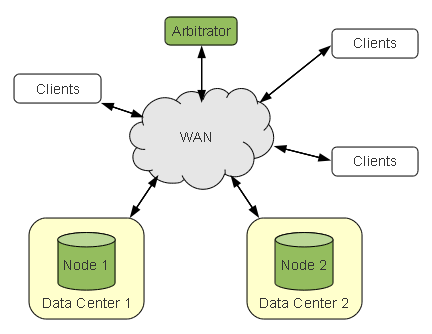
Galera Arbitrator Galera Cluster Documentation

Install Mariadb Galera Cluster On Centos 7

Monitoring Galera Cluster For Mysql Or Mariadb Understanding Metrics Updated Severalnines

Galera Mysql Cluster With Vips And Haproxy For Ido Mysql And More Howto Icinga Community

Galera Cluster For Mysql The World S Most Advanced Open Source Database Cluster

Galera Cluster Programmer Sought

How To Deploy A Mariadb Galera Cluster On Ubuntu 14 04 Vexxhost

Proof Of Concept Irods Mariadb Galera Cluster

Galera Malti Master Cluster Monitoring With Prometheus And Grafana Dumi S Blog

How To Set Up A Mariadb Galera Cluster On Ubuntu 16 04 Techrepublic

Monitoring Galera Cluster For Mysql Or Mariadb Understanding Metrics Updated Severalnines

Setup Maxscale With Mariadb Cluster Nilinfobin
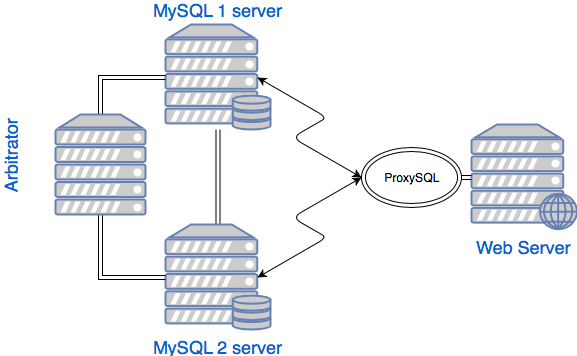
High Availability With A Mariadb Galera Mysql Cluster With Proxysql Tutorial Mysql Mariadb Hostek Community
Knowledge Sharing Mariadb Galera Cluster In Centos 7

Maxscale Split Read Write Query Mariadb Galera Cluster My Documents

How To Setup Mariadb Galera Cluster On Centos 7 Debyum

How To Deploy A Mariadb Galera Cluster On Ubuntu 14 04 Vexxhost

How To Set Up A Mariadb Galera Cluster On Ubuntu 16 04 Techrepublic

Updated How To Bootstrap Mysql Or Mariadb Galera Cluster Cloud Data Architect
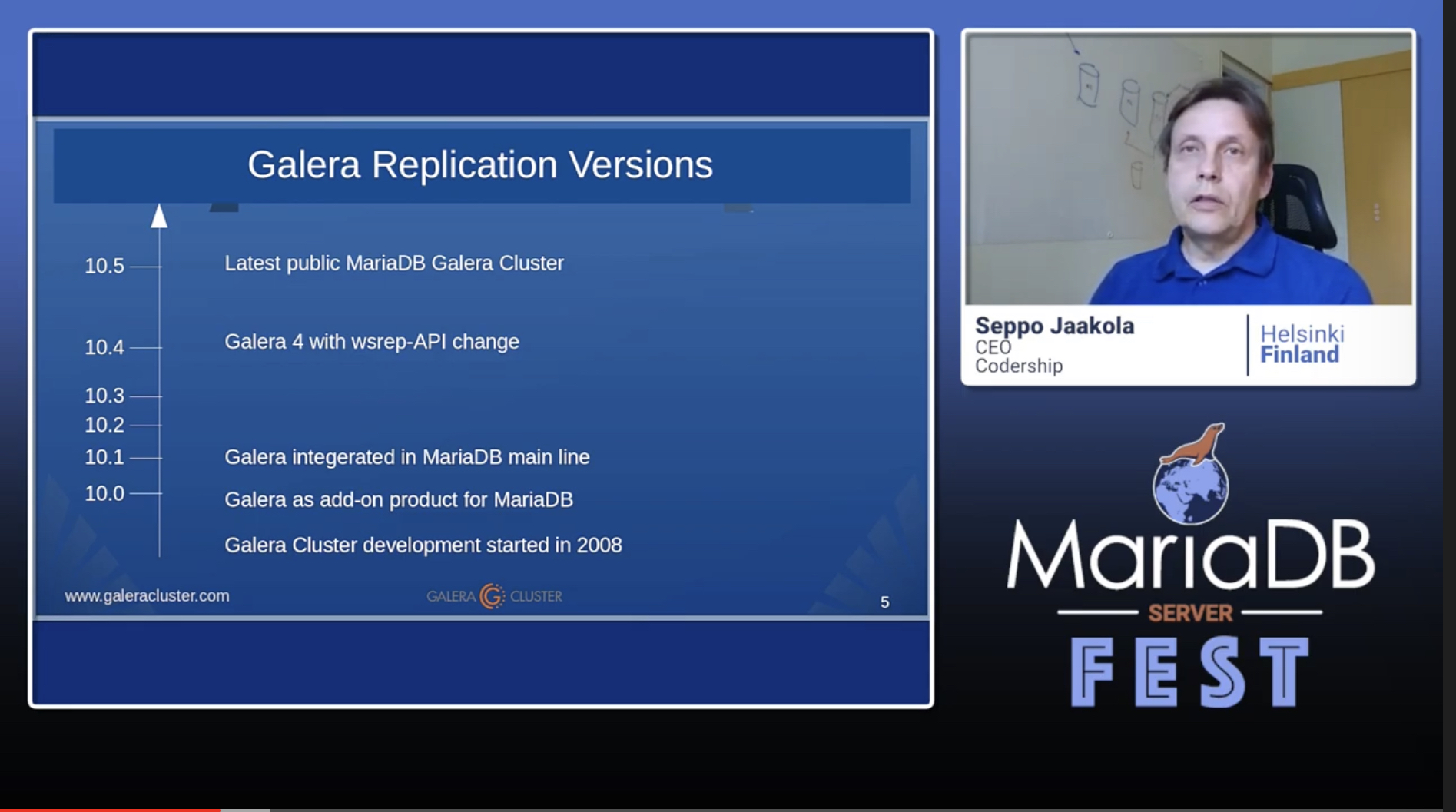
Galera Clustering In Mariadb 10 5 And Beyond Galera Cluster For Mysql

Install And Configure Mariadb Galera 4 Cluster On Centos 7 In Virtualbox Kaysar Iqbal

How To Encrypt Replication Traffic In Mariadb Galera Cluster On Ubuntu

How To Recover Mariadb Galera Cluster After Partial Or Full Crash Symmcom

Running A Mariadb Galera Cluster On Openshift

How To Install And Configure Mariadb Galera As Master To Master Replication Cluster On Ubuntu 16 04 Lts Nixcraft

How To Check Status Of Mariadb Galera Cluster Unisonunix

How To Set Up A Mariadb Galera Cluster On Ubuntu 16 04 Techrepublic

How To Deploy A Mariadb Galera Cluster On Ubuntu 14 04 Vexxhost

Galera Cluster For Mysql The World S Most Advanced Open Source Database Cluster
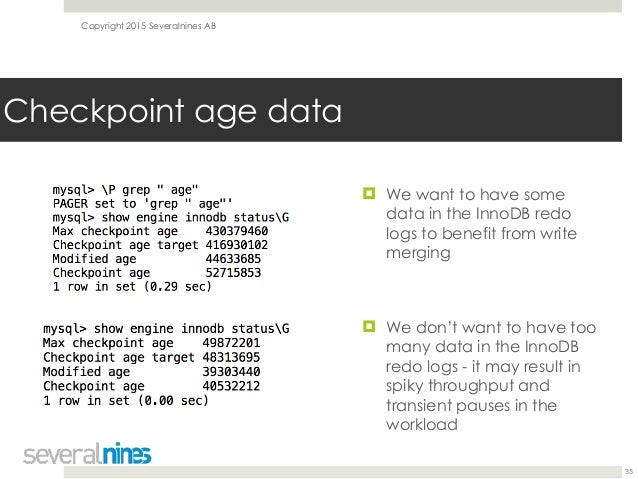
Deep Dive Into How To Monitor Mysql Or Mariadb Galera Cluster Perco

How To Deploy A Production Ready Mysql Or Mariadb Galera Cluster Using Clustercontrol Database News Php Developers

Deploying An Asynchronous Slave To Mysql Galera Cluster Severalnines

One Of The Node Can Not Start The Mariadb In Galera Cluster Stack Overflow

Install And Configure Galera Mysql Cluster On Centos 7 Server

Galera Cluster For Mysql The World S Most Advanced Open Source Database Cluster

Setup Mariadb Galera Cluster On Ubuntu 18 04 With Haproxy Computingforgeeks
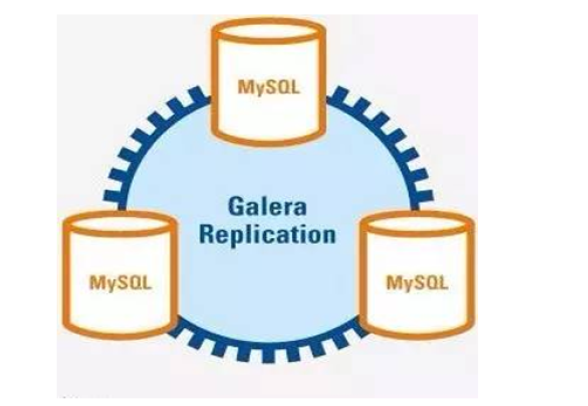
Mysql Cluster Highly Available
How To Check Status Of Mariadb Galera Cluster Unisonunix

How To Setup Mariadb Galera Cluster On Centos 7 Debyum

How To Setup Mariadb Galera Cluster With Haproxy On Centos 7

Galera Cluster Monitoring And Integration With Zabbix
How To Check Status Of Mariadb Galera Cluster Unisonunix

Galera Mysql Cluster With Vips And Haproxy For Ido Mysql And More Howto Icinga Community

Deploying A Mariadb 10 4 Galera Cluster With Clustercontrol Blog Dbi Services

Monitoring Galera Cluster For Mysql Or Mariadb Understanding Metrics Updated Severalnines

Monitoring Galera Cluster For Mysql Or Mariadb Understanding Metrics Updated Severalnines

How To Setup A Mariadb Cluster With Galera And Haproxy Cyral

How To Install Galera Cluster And Configure On Centos 7 Fosnix

How Can Docker Help A Mariadb Cluster For Disaster Recovery Blog Dbi Services
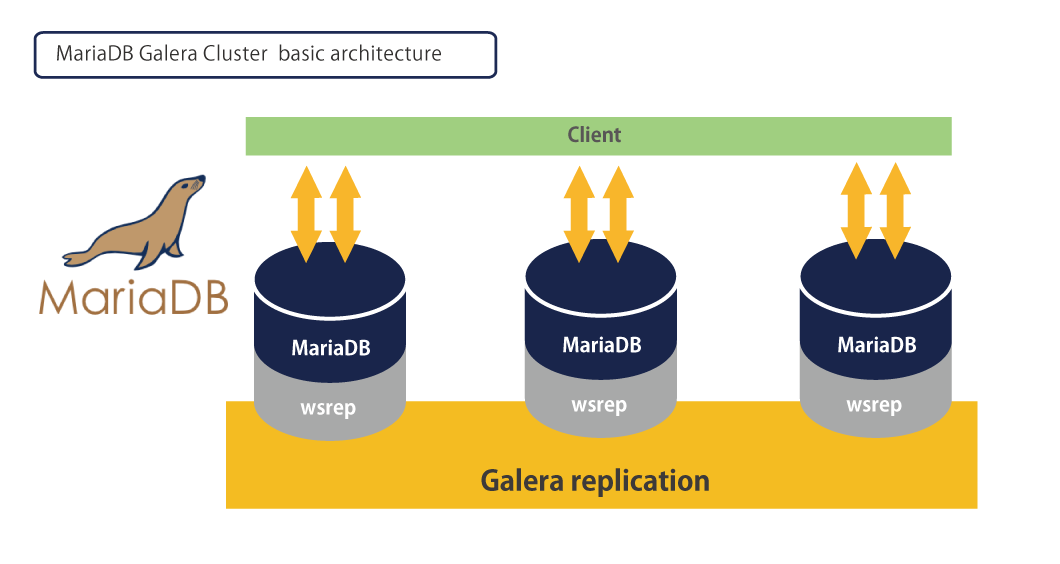
Mariadb Galera Cluster On Centos 7 By Ilham Bayramov Medium
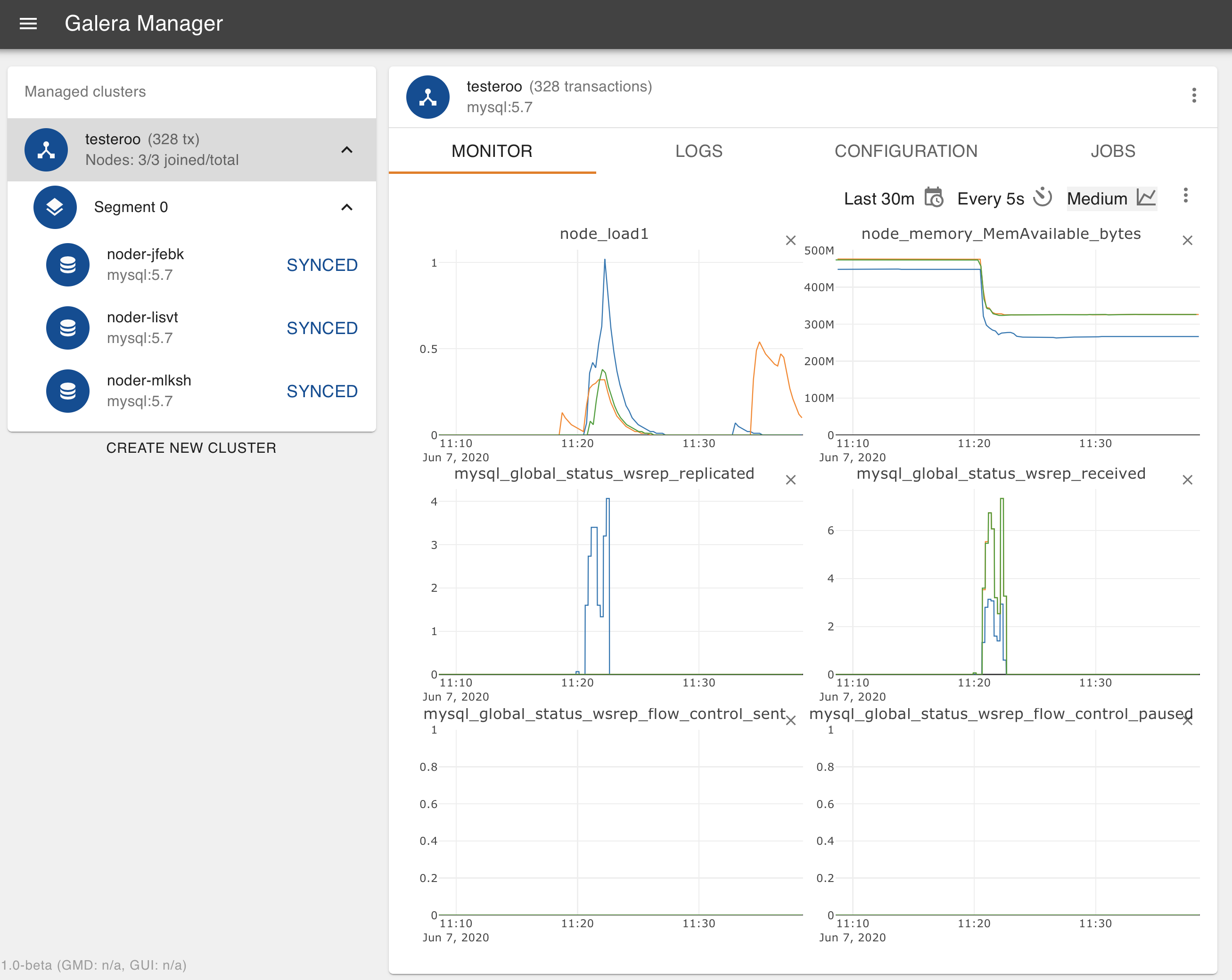
Monitoring A Cluster With Galera Manager Galera Cluster Documentation

Replication Channel Fail Over With Galera Cluster For Mysql Fromdual

Codership And Severalnines Joint Webinar How To Manage Galera Cluster Using Clustercontrol Youtube



